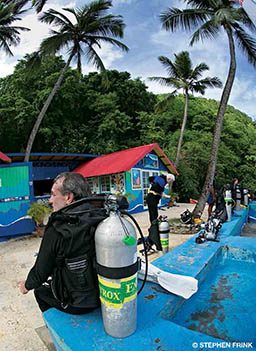“No matter where on earth you live,
most of the oxygen in the atmosphere is generated by the sea.”
— Sylvia Earle
French physiologist Paul Bert first proposed diving with a mixture of air and additional oxygen in the late 19th century. The first dives with oxygen-enriched air were made using early closed-circuit rebreathers, and in 1978 the National Oceanic and Atmospheric Administration (NOAA) adopted enriched-air nitrox — a combination of oxygen and nitrogen — for scientific diving. When enriched-air nitrox first became available for recreational divers in the mid-1980s, many people were concerned that the risks of suffering an oxygen-toxicity seizure were too great for the entire recreational diving community to safely manage. These seizures occur when a diver exceeds the maximum recommended depth for the gas being inhaled and the partial pressure of oxygen becomes too high to breathe safely. Ten years later, some of the world’s largest training agencies launched nitrox diver training courses. By 2000, when DAN® hosted a nitrox diving workshop, diving with nitrox was mainstream and here to stay.

Last year, DAN researchers analyzed nearly 400 U.S. recreational diving fatalities over a 10-year period to examine the occurrence of oxygen-toxicity seizures. Were those fears some people expressed in the early days justified? The final data set studied included 344 air divers (86 percent) and 55 nitrox divers (14 percent), ages 14 to 78. The average oxygen content in the nitrox was 31 percent.
The researchers found that the nitrox divers were more commonly diving in equipment they personally owned and that the depth of the fatal dives was significantly deeper for the nitrox divers than for the air divers. This finding seemed counterintuitive at first, since the safe maximum operating depth of nitrox is shallower than that of air, but when you factor in the cost of a nitrox fill (which is typically more expensive than air), it makes sense that divers going to shallow depths with longer no-decompression limits would be less likely to pay extra for nitrox.
Only one out of the 55 nitrox fatalities was considered likely due to oxygen-toxicity seizures. An experienced technical diver had filled a set of double cylinders with enriched-air nitrox containing 32 percent oxygen (EAN32) for a dive that was later canceled. Some weeks later he used the filled cylinders for a technical dive to a depth of around 160 feet, which is deeper than the maximum operating depth for EAN32. While breathing the nitrox, the diver descended to 160 feet, slowly ascended to 130 feet and then suffered a seizure and sank back down to 160 feet, according to his dive computer’s recorded profile. The diver owned multiple tanks, and he may have simply forgotten those particular tanks contained nitrox. This rare case is a reminder to analyze and correctly mark tanks containing nitrox, as divers are taught to do during nitrox courses.
In the past 25 years, nitrox has gone from being warily regarded to being the gas of choice in many dive operations. It would have been difficult to imagine 30 years ago that today liveaboard dive boats would be organizing thousands of dives on nitrox. We estimate U.S. divers make millions of dives each year while breathing nitrox. While oxygen toxicity may have caused more fatalities than DAN is aware of, research shows that the fears expressed when nitrox was first used in recreational diving have not been realized. There can be little doubt this is due to the entire diving community working together: the gas blenders getting the mix right, instructors teaching how to safely dive with nitrox, and divers knowing to analyze their gas when they collect it from the shop and planning their maximum operating depth accordingly.
Note: The full paper reporting this study appeared in the March 2017 issue of the medical journal Brain Injury and was described at the 2017 annual scientific meeting of the Undersea and Hyperbaric Medical Society as one of six highlight papers of the year. DAN congratulates the nitrox diving community for maintaining safe nitrox diving practices. We urge everyone to remain vigilant: Always analyze the oxygen content, and clearly mark it and the maximum operating depth on the tank.
| © Alert Diver — Q2 2018 |